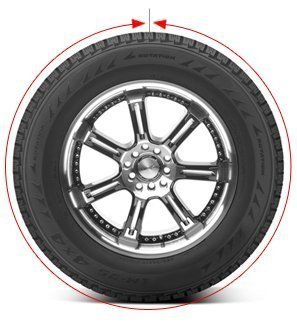
There are a lot of questions and plenty of confusion regarding the replacement of tires on four-wheel drive (4WD) and all-wheel drive (AWD) vehicles. The most common question is “Do I really need to replace all four tires on my vehicle?" While the short answer is often yes, we'd like to help explain the importance of this response.
Today's AWD vehicles (also referred to as full-time four-wheel drive) are designed to monitor the wheel speed of the tires. The purpose is to detect any slippage that would activate portions of the all-wheel-drive system. This is accomplished by using differentials or viscous couplings (sometimes both) to allow for differing wheel speeds experienced when cornering or encountering loose pavement (and momentarily spinning a wheel). The ideal system will send precisely the right amount of torque to each wheel, which is the maximum torque that won't cause that tire to slip.
When the circumferences of tires are not matched, the number of times the tire revolves per mile can vary by tire. This can occur when tires are replaced with no attention paid to the qualities that affect circumference like size, manufacturer, type and tread wear. Most differential systems are designed to allow short-term differences in wheel speeds when the vehicle turns a corner or spins a tire. If you use mismatched tires (tires of different size, type, manufacturer or tread depth), you may be forcing the differentials to operate at all times. This will lead to excessive heat and unnecessary wear on the differential, and may cause early failure.
As a policy, Dunn Tire will follow the tire replacement recommendations in each vehicle's owner manual. We don't create these guidelines, but they are in place for a reason. The top priorities are vehicle safety and optimal performance. We do not cut corners nor attempt to mislead customers.
As an example, let's look at Subaru's policy on tire replacement:
Tire Replacement. The wheels and tires are important and integral parts of your vehicle's design; they cannot be changed arbitrarily. The tires fitted as standard equipment are optimally matched to the characteristics of the vehicle and were selected to give the best possible combination of running performance, ride comfort, and service life. It is essential for every tire to have a size and construction as well as a speed symbol and load index matching those shown on the tire placard. Using tires of a non-specified size detracts from controllability, ride comfort, braking performance and speedometer and odometer accuracy. It also creates incorrect body-to-tire clearances and inappropriately changes the vehicle's ground clearance. All four tires must be the same in terms of manufacturer, brand (tread pattern), construction, and size. You are advised to replace the tires with new ones that are identical to those fitted as standard equipment.
For safe vehicle operation, SUBARU recommends replacing all four tires at the same time. WARNING: All four tires must be the same in terms of manufacturer, brand (tread pattern), construction, degree of wear, speed symbol, load index and size. Mixing tires of different types, sizes or degrees of wear can result in damage to the vehicle's power train. Use of different types or sizes of tires can also dangerously reduce controllability and braking performance and can lead to an accident. Use only radial tires. Do not use radial tires together with belted bias tires and/or bias-ply tires. Doing so can dangerously reduce controllability which can result in an accident.
